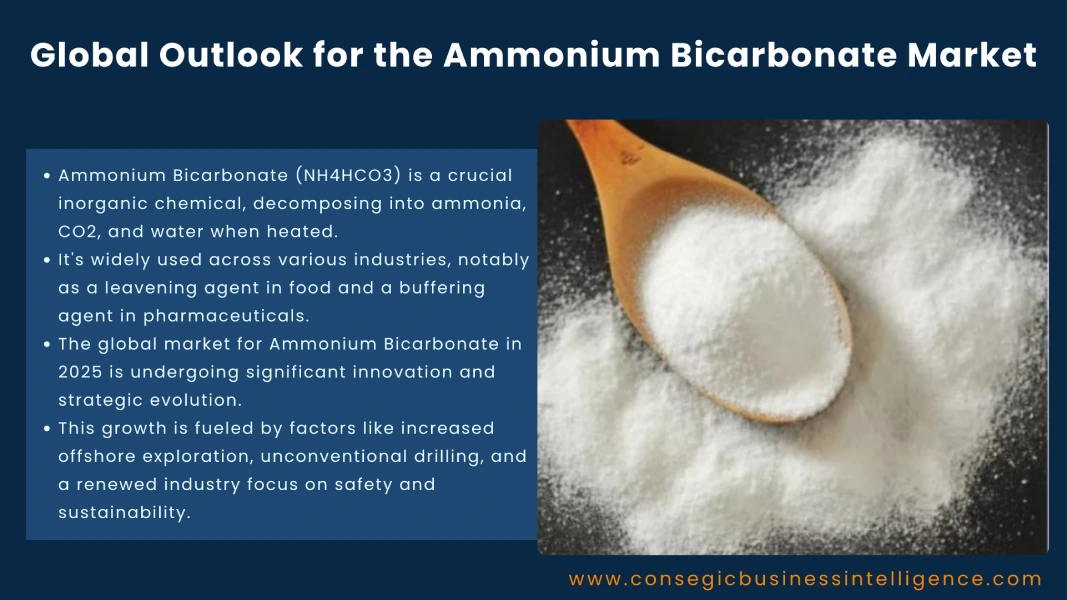Global Outlook for the Ammonium Bicarbonate Market
Ammonium Bicarbonate (NH4HCO3) is an inorganic chemical compound, when heated, it decomposes into ammonia, carbon dioxide, and water. It is used for various applications in multiple industries, such as a buffering agent in certain pharmaceutical processes and a leavening agent in the food industry, etc.

This blog highlights the outlook of the ammonium bicarbonate across the globe, listing down the industries that are driving its growth.
- Asia-Pacific
The Asia-Pacific region is the dominant player in the ammonium bicarbonate market, accounting for nearly 45 percent of global demand. This growth is primarily fueled by China, which remains both the largest producer as well as the consumer of the compound.
As ammonium bicarbonate is widely used as a nitrogen fertilizer in crops such as rice, wheat, and maize, the agricultural sector is a major factor leading to market growth. In addition, with rising populations and increasing concerns about food security, countries such as India, China, and Southeast Asian nations are ramping up fertilizer use, thereby increasing crop yields. The food processing industry, particularly the baking sector, is a significant consumer of ammonium bicarbonate. Furthermore, industrial demand is increasing with ammonium bicarbonate being used in the production of ceramics, dyes, pharmaceuticals, and various other products. These diverse applications are leading to the rapid expansion of the ammonium bicarbonate market in the Asia-Pacific region.
- North America
Owing to the region’s advanced agricultural practices and increasing adoption of sustainable farming methods, North America is a significant consumer of ammonium bicarbonate compound. Countries including the United States and Canada use ammonium bicarbonate not just in fertilizers for crop production, but also in the food industry as a leavening agent in baking powder. Moreover, in pharmaceuticals, it is being used in antacids. The market growth is further supported by government policies for sustainable agriculture and chemical production incentives.
- Europe
The European region holds about 26 percent of the global ammonium bicarbonate market share. Countries including, Germany, France, and Italy being the major consumers of this chemical compound. The region has seen moderate growth primarily in the food industry, where organic baking agents are being increasingly preferred. While demand in the bakery sector remains solid, the agricultural use of ammonium bicarbonate has declined due to strict environmental policies by the government limiting nitrogen emissions. Industrial applications in textiles and chemicals continue to support the market, but rising compliance costs and environmental constraints pose challenges to market growth.
- Latin America
Latin America holds around 5 percent of the global ammonium market, presenting a moderate growth of the market. Countries, including Brazil and Argentina, are its major consumers, leading to its rising market demand. In addition, the agricultural sector is the key player driving the market, with cost-effective fertilizers to support large-scale crop production. The growing focus on organic farming and food processing industries, such as baking and beverage sectors, significantly contribute to the market growth in the region.
- Middle East and Africa
Middle East & Africa (MEA) has seen potential growth in the ammonium bicarbonate market, particularly in Egypt, South Africa, and Nigeria. The increasing focus on food security and the expansion of arable land is driving the demand for ammonium bicarbonate. In addition, rising urban populations and the rise of food processing industry are boosting the market demand.
Hence, Asia Pacific, followed by North America, is the major consumer of ammonium carbonate compounds. Furthermore, regions including Europe, Latin America, and Middle East, and Africa maintain a stable share in the ammonium bicarbonate market. Owing to the region’s increasing population and advanced agricultural practices, there is a rise in demand for chemical compounds, leading to its market growth. In addition, the food industry such as baking and beverage sector also play a major role in boosting the ammonium bicarbonate market development.
Conclusion
In conclusion, the global ammonium bicarbonate market is influenced by region-specific dynamics including agricultural demand, industrial applications, regulatory policies, and the evolving food consumption trends. Asia-Pacific leads the market with strong agricultural and food processing sectors, underpinned by cost-effective production and growing consumption. North America holds a majority share of the market due to its demand being driven by sustainable farming practices and consistent use in pharmaceuticals and bakery industries. Europe, while maintaining a significant market share, is constrained by stringent environmental regulations that limit fertilizer usage, although niche food and industrial applications persist. The Middle East and Africa continue to remain the emerging regions for the ammonium bicarbonate market growth, owing to their expanding agricultural activities and rising demand for food-grade applications. However, growth is being slightly hampered by logistical and supply chain challenges. Latin America, is witnessing gradual growth backed by increasing agricultural investments and organic farming support.
Across all regions, the affordability and multi-functionality of ammonium bicarbonate continue to make it a preferred compound, especially in developing economies. However, rising environmental concerns and the availability of alternative chemicals may pose challenges to long-term growth. As global markets shift towards sustainable solutions, innovation and regulatory alignment will play a crucial role in shaping the future landscape of the ammonium bicarbonate industry.
